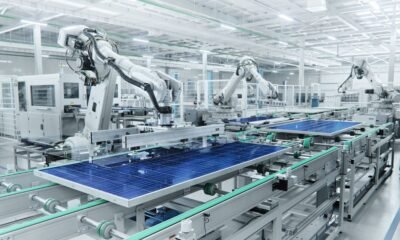Tech
Prototype Manufacturing: A Guide for Engineers and Designers

Prototypes allow designers and engineers to test, alter, and validate their designs before mass-producing them. This article discusses prototyping, its processes, and how a rapid prototyping factory may help you realize your vision.
How Are Prototypes Made?
A prototype is a model or sample of a product created to test its design, functionality, and performance. This approach helps identify potential issues early on, allowing for product improvements before mass production.
Significant Prototype Manufacturing Benefits
Prototypes allow engineers and designers to test their ideas, ensuring the final product meets user needs and criteria.
Design flaws detected early in development can decrease subsequent decision costs.
Rapid prototyping factories can speed up manufacturing, allowing faster iterations and a shorter time to market.
By discovering difficulties before mass production, prototyping reduces risks and improves product quality.
Different Types of Prototypes
Visible prototypes
Visual prototypes show the product’s shape, size, and look without functioning features. These are often used for presentations and evaluations early in design.
Functional prototypes
Functional prototypes test product functionality and performance. These more detailed models may use similar materials to the final result.
Demonstration prototypes
Prototypes test and demonstrate the feasibility of design features. Concepts and assumptions are often refined and validated early in development.
Choose a Rapid Prototyping Factory
Rapid prototyping factories use 3D printers, CNC machines, and vacuum casting equipment to produce high-quality prototypes quickly. Consider these factors while choosing a factory:
To ensure that your factory understands your prototype’s criteria, select one with experience in your industry.
Make sure the factory has the tools and technologies for your prototype.
Find a factory with fast turnaround times to speed up your development process.
Assess the pricing structure and ensure it matches your financial plan.
Manufacturing Using Prototypes
Concept Development
Create a detailed product concept and design before starting. During this phase, you will brainstorm, sketch, and create a digital model using CAD software.
Material Selection
Your prototype should be made of materials that match the product’s purpose, function, and appearance.
Making Prototypes
Depending on the part structures, prototype manufacturing methods, like 3D printing, CNC machining, or vacuum casting, can be used. Rapid prototyping manufacturers can help you choose the best method.
Testing and Assessing
Test the prototype for design and performance issues. Collect stakeholder feedback to improve.
Iterative Process
Use test findings and feedback to improve the design. The prototype may be revised several times to obtain perfection.
Acceptance of Final Prototype
After mass production approval, the prototype must meet all criteria and pass testing.
Conclusion
Prototypes are crucial to product development. It helps engineers and designers develop their ideas and launch their products faster. By partnering with a reputable rapid prototyping manufacturer, you can use their expertise and technology to create high-quality prototypes that meet your needs.
FAQs
How much time does it take to manufacture a prototype?
The complexity of the design, the manufacturing process selected, and the materials utilized all affect how long it takes. It may take a few hours for straightforward 3D-printed components or many weeks for intricate, multi-part prototypes.
What distinguishes rapid prototyping from conventional prototyping?
Rapid prototyping uses 3D CAD data to quickly create a scale model of a physical part or assembly. Compared to conventional prototyping techniques, it uses cutting-edge technology like 3D printing and CNC machining to shorten development times and save costs.
What kinds of obstacles do prototype manufacturers frequently face?
Typical obstacles include material constraints, intricate designs, meeting tolerance requirements, expensive procedures for certain techniques, and ensuring the prototype faithfully depicts the finished product.
What is the usual cost of making a prototype?
The choice of material, the production process, the complexity of the prototype, and the quantity all affect costs. Larger or more intricate prototypes can cost thousands, while a basic 3D-printed prototype might cost $50.
Can the production of prototypes be contracted out?
Indeed, a lot of businesses focus on providing prototype manufacturing services. Through outsourcing, one can obtain specialized tools and knowledge, frequently saving time and cost.
What part does CAD software play in the creation of prototypes?
Prototyping requires CAD (Computer-Aided Design) tools to create detailed digital models. By guiding the production process, these models guarantee accuracy and precision.
What is the significance of prototype production?
Engineers and designers may verify their ideas, find design faults, test materials, and streamline production via prototype manufacturing. It guarantees that the finished product meets client expectations and quality requirements.
-

 Tech1 year ago
Tech1 year agoHow to Use a Temporary Number for WhatsApp
-

 Business2 years ago
Business2 years agoSepatuindonesia.com | Best Online Store in Indonesia
-

 Social Media1 year ago
Social Media1 year agoThe Best Methods to Download TikTok Videos Using SnapTik
-

 Technology1 year ago
Technology1 year agoTop High Paying Affiliate Programs
-

 Tech10 months ago
Tech10 months agoUnderstanding thejavasea.me Leaks Aio-TLP: A Comprehensive Guide
-

 FOOD12 months ago
FOOD12 months agoHow to Identify Pure Desi Ghee? Ultimate Guidelines for Purchasing Authentic Ghee Online
-

 Instagram3 years ago
Instagram3 years agoFree Instagram Auto Follower Without Login
-

 Instagram3 years ago
Instagram3 years agoFree Instagram Follower Without Login






















